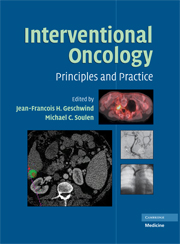Book contents
- Frontmatter
- Contents
- FOREWORD
- ACKNOWLEDGMENTS
- CONTRIBUTORS
- PART I PRINCIPLES OF ONCOLOGY
- PART II PRINCIPLES OF IMAGE-GUIDED THERAPIES
- 5 Image-guided Interventions: Fundamentals of Radiofrequency Tumor Ablation
- 6 Principles of Embolization
- 7 Imaging in Interventional Oncology: Role of Image Guidance
- 8 Assessment of Tumor Response on Magnetic Resonance Imaging after Locoregional Therapy
- PART III ORGAN-SPECIFIC CANCERS
- PART IV SPECIALIZED INTERVENTIONAL TECHNIQUES IN CANCER CARE
- INDEX
- Plate section
- References
5 - Image-guided Interventions: Fundamentals of Radiofrequency Tumor Ablation
from PART II - PRINCIPLES OF IMAGE-GUIDED THERAPIES
Published online by Cambridge University Press: 18 May 2010
- Frontmatter
- Contents
- FOREWORD
- ACKNOWLEDGMENTS
- CONTRIBUTORS
- PART I PRINCIPLES OF ONCOLOGY
- PART II PRINCIPLES OF IMAGE-GUIDED THERAPIES
- 5 Image-guided Interventions: Fundamentals of Radiofrequency Tumor Ablation
- 6 Principles of Embolization
- 7 Imaging in Interventional Oncology: Role of Image Guidance
- 8 Assessment of Tumor Response on Magnetic Resonance Imaging after Locoregional Therapy
- PART III ORGAN-SPECIFIC CANCERS
- PART IV SPECIALIZED INTERVENTIONAL TECHNIQUES IN CANCER CARE
- INDEX
- Plate section
- References
Summary
KEY POINTS
Radiofrequency (RF) ablation is a viable alternative for the treatment of many solid focal malignancies, especially in the non-surgical candidate.
Benefits of RF ablation include low morbidity and mortality, low cost, non-surgical patient inclusion, and same-day discharge.
Successful treatment is a balance between complete tumor destruction and minimizing damage to surrounding normal parenchyma and adjacent structures.
The bio-heat equation states: coagulation necrosis = energy deposited × local tissue interactions – heat loss. This forms the foundation of RF ablation.
Widespread adoption of RF ablation will rely upon improving and increasing tumor ablation volume. Adjuvant therapies such as antiangiogenetics, chemotherapeutics, embolization, and radiation in this capacity hold great promise.
INTRODUCTION
Minimally invasive RF ablation continues to gain attention as a viable option for the treatment of multiple solid malignancies given continued favorable outcome studies coupled with scarce complications (1–4). Advantages of RF ablation include a wider spectrum of patients, including non-surgical candidates and outpatients, along with lower immediate morbidity and mortality, and lower cost (5–6). For these reasons and impressive initial outcomes, the indications continue to broaden to include multiple tumor types, multiple locations and ever-expanding patient selection criteria. Currently, the most commonly ablated tumor worldwide is focal hepatic cell carcinoma (HCC), but rapid acceptance of renal cell carcinoma (RCC) has been shown in many parts of the world, including the United States (7–12).
- Type
- Chapter
- Information
- Interventional OncologyPrinciples and Practice, pp. 55 - 66Publisher: Cambridge University PressPrint publication year: 2008



